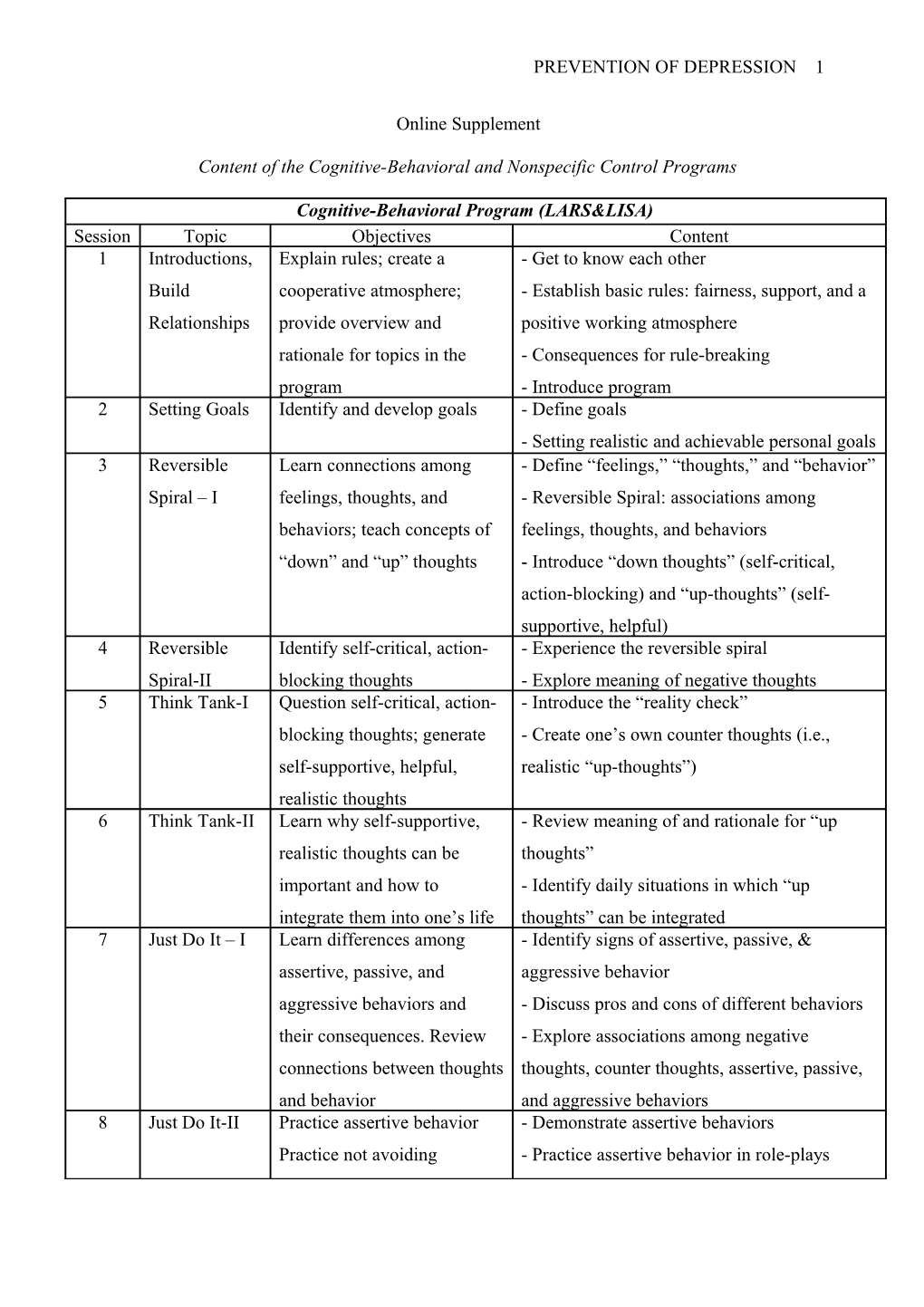1
PREVENTION OF DEPRESSION
Online Supplement
Content of the Cognitive-Behavioral and Nonspecific Control Programs
Cognitive-Behavioral Program (LARS&LISA)Session / Topic / Objectives / Content
1 / Introductions, Build Relationships / Explain rules; create a cooperative atmosphere; provide overview and rationale for topics in the program / - Get to know each other
- Establish basic rules: fairness, support, and a positive working atmosphere
- Consequences for rule-breaking
- Introduce program
2 / Setting Goals / Identify and develop goals / - Define goals
- Setting realistic and achievable personal goals
3 / Reversible Spiral – I / Learn connections among feelings, thoughts, and behaviors; teach concepts of “down” and “up” thoughts / - Define “feelings,” “thoughts,” and “behavior”
- Reversible Spiral: associations among feelings, thoughts, and behaviors
- Introduce “down thoughts” (self-critical, action-blocking) and “up-thoughts” (self-supportive, helpful)
4 / Reversible Spiral-II / Identify self-critical, action-blocking thoughts / - Experience the reversible spiral
- Explore meaning of negative thoughts
5 / Think Tank-I / Question self-critical, action-blocking thoughts; generate self-supportive, helpful, realistic thoughts / - Introduce the “reality check”
- Create one’s own counter thoughts (i.e., realistic “up-thoughts”)
6 / Think Tank-II / Learn why self-supportive, realistic thoughts can be important and how to integrate them into one’s life / - Review meaning of and rationale for “up thoughts”
- Identify daily situations in which “up thoughts” can be integrated
7 / Just Do It – I / Learn differences among assertive, passive, and aggressive behaviors and their consequences. Review connections between thoughts and behavior / - Identify signs of assertive, passive, & aggressive behavior
- Discuss pros and cons of different behaviors
- Explore associations among negative thoughts, counter thoughts, assertive, passive, and aggressive behaviors
8 / Just Do It-II / Practice assertive behavior
Practice not avoiding / - Demonstrate assertive behaviors
- Practice assertive behavior in role-plays
9 / Making Contact-I / Learn how to build and maintain friendships / - Demonstrate verbal and nonverbal strategies to signal interest in others
- Role-play “making contact”
10 / Making Contact-II / Practice building friendships. Obtain feedback about the program / - Participants evaluate and provide feedback
- Hand out certificates of program completion
- Good-byes and celebration
Nonspecific Control Condition
Session / Topic / Objectives / Content
1 / Introductions to the program and each other / Explain rules; create a cooperative atmosphere; provide an overview of the content of the program / - Get to know each other
- Establish basic rules: fairness, support, and a positive working atmosphere
- Consequences for rule-breaking
- Introduce program
2 / Goals / Define and develop goals / - What is a goal? Goals we have in common.
3 / Feelings I / Learn about feelings / - What are feelings? Which feelings do I know?
4 / Feelings II / Learn about others’ feelings / - How do I know how others feel?
- What makes me feel… (e.g., sad)?
5 / Opinions / Learn about subjective and objective opinions / - What are opinions?
- Who influences our opinions?
6 / Expectations / Learn about the influence of expectations / - Who expects something of me?
- Can I meet others’ expectations?
7 / Communication / Learn about verbal and nonverbal communication / - What is nonverbal communication?
- Verbal & nonverbal communication
8 / Making contact / Learn about first impressions and different levels of knowing someone / - What goes into a first impression?
- Types of people we meet in different situations
- How much do we know about others?
9 / Friendship / Discuss “friendship” / - What is “friendship”? What is a good friend?
- Why we select the friends we do
10 / Closing and Goodbyes / Obtain feedback about the program; Good-byes and celebration / - Participants evaluate and provide feedback about the program
- Hand out certificates of program completion
